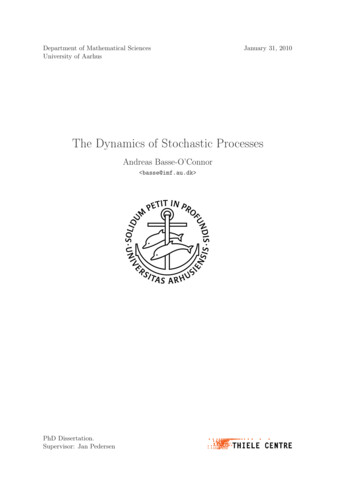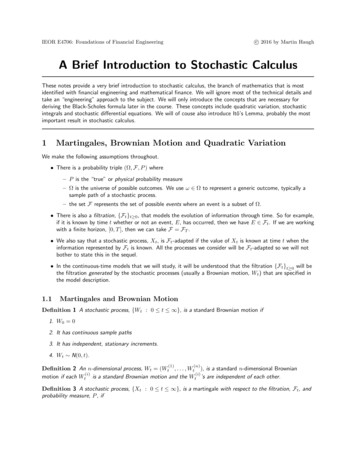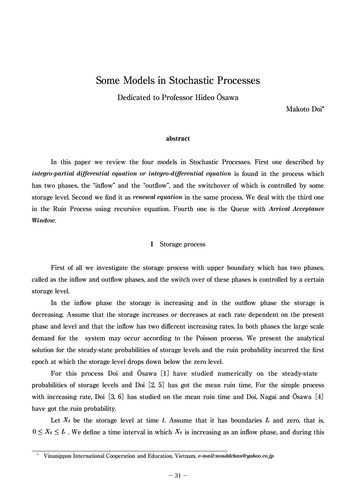
Transcription
Department of Mathematical SciencesUniversity of AarhusJanuary 31, 2010The Dynamics of Stochastic ProcessesAndreas Basse-O’Connor basse@imf.au.dk PhD Dissertation.Supervisor: Jan Pedersen
l classes of stochastic processes . . .2The semimartingale property . . . . . . . . . . .3The semimartingale property of moving averages4Integrability of seminorms . . . . . . . . . . . .5Martingale-type processes indexed by R . . . . .6Quasi Ornstein-Uhlenbeck processes . . . . . . .References . . . . . . . . . . . . . . . . . . . . . . . . .116811121213.A Representation of Gaussian semimartingales with application to thecovariance function16by Andreas Basse-O’Connor1Introduction . . . . . . . . . . . . . . . . . . . . . . .2Preliminary results . . . . . . . . . . . . . . . . . . .3General properties of Gaussian semimartingales . . .4Representation of Gaussian semimartingales . . . . .5The covariance function of Gaussian semimartingalesReferences . . . . . . . . . . . . . . . . . . . . . . . . . . .B Spectral representation of Gaussian semimartingales17192122293436by Andreas Basse-O’Connor1Introduction . . . . . . . . . . .2Notation and random measures3Preliminary results . . . . . . .4Main results . . . . . . . . . . .References . . . . . . . . . . . . . . .C Gaussian moving averages and semimartingales373839424951by Andreas Basse-O’Connor1Introduction . . . . . . . . . . . . . . . . . . . . . . . . .2Notation and Hardy functions . . . . . . . . . . . . . . .3Main results . . . . . . . . . . . . . . . . . . . . . . . .4Functions with orthogonal increments . . . . . . . . . .5Proofs of main results . . . . . . . . . . . . . . . . . . .6The spectral measure of stationary semimartingales . . .7The spectral measure of semimartingales with stationaryReferences . . . . . . . . . . . . . . . . . . . . . . . . . . . . . . . . . . . . . . . . . . . . . . . . . . . . . . . . . . . . . . . . .increments. . . . . . .5253555963687273ii
ContentsD Lévy driven moving averages and semimartingales75by Andreas Basse-O’Connor and Jan Pedersen1Introduction .2Preliminaries3Main results .4Proofs . . . .5The two-sidedReferences . . . . . . . . . . . . .case. . .E Path and semimartingale properties of chaos processes76778082909598by Andreas Basse-O’Connor and Svend-Erik Graversen1Introduction . . . . . . . . . . .2Preliminaries . . . . . . . . . .3Path properties . . . . . . . . .4Semimartingales . . . . . . . .5The semimartingale property ofReferences . . . . . . . . . . . . . . . . . . . . . . . . . . . . . . . . . . . . . . . . . . . . . . . . . . .moving averages. . . . . . . . . .F Integrability of seminorms9999102107111115117by Andreas Basse-O’Connor1Introduction2Main results3Two proofsReferences . . . .G Martingale-type processes indexed by.R118121126130132by Andreas Basse-O’Connor, Svend-Erik Graversen and Jan Pedersen1Introduction . . . . . . . .2Preliminaries . . . . . . .3Martingales and increment4Stochastic integration . .References . . . . . . . . . . . . . . . . . . . . . . . .martingales. . . . . . . . . . . . .H Quasi Ornstein-Uhlenbeck processes133134136148151153by Ole E. Barndorff-Nielsen and Andreas Basse-O’Connor1Introduction . . . . . . . . . . . . . . . .2Langevin equations and QOU processes3A Fubini theorem for Lévy bases . . . .4Moving average representations . . . . .5Conclusion . . . . . . . . . . . . . . . .References . . . . . . . . . . . . . . . . . . . .154154162165173174iii
PrefaceThis dissertation constitutes the result of my PhD studies at the Department of Mathematical Science, Aarhus University. These studies have been carried out from February1, 2006 to January 31, 2010 under the supervision of Jan Pedersen (Aarhus University).Main problemsThe present dissertation focuses primarily on the dynamics (i.e. the evolution over time)of different kinds of stochastic processes. In particular the semimartingale propertywill be important to us, but also path properties such as p-variation, continuity andintegrability of seminorms will be considered. The dynamics of solutions to ordinarystochastic differential equations, as in e.g. Protter [8], are always semimartingales andhence most of their probabilistic properties, as e.g. path properties, are well understood.However, for more complicated models such as stochastic fractional differential equations(see [2, 1]), stochastic partial differential equations (see [3, 9]), stochastic delay equations(see [5]) or stochastic Volterra equations (see [6, 7]), the solution is in general not asemimartingale and it is only in special cases that the dynamics of such processes isknown. Moreover, many phenomenons, e.g. in finance and turbulence, are well describedby stationary or stationary increment processes; an important subclass herein is movingaverages. Both in theory and applications it is crucial to know the dynamics of suchprocesses; but this remains an open problem except in simple cases, see e.g. BarndorffNielsen and Schmiegel [4]. In addition to the above problems we will also be interestedin properties of stationary solutions to the Langevin equation driven by a stationaryincrement process, and a development of an applicable martingale theory for processesindexed R.About the DissertationThe dissertation consists of the following eight manuscripts:Manuscript A: Representation of Gaussian semimartingales with application to the covariancefunction. Stochastics: An International Journal of Probability and StochasticProcesses, (2009), 21 pages. In Press.Manuscript B: Spectral representation of Gaussian semimartingales. Journal of TheoreticalProbability 22 (4), (2009), 811–826.Manuscript C: Gaussian moving averages and semimartingales. Electronic Journal of Probability 13, no. 39, (2008), 1140–1165.Manuscript D: Lévy driven moving averages and semimartingales (with J. Pedersen). Stochastic Processes and their Applications 119 (9), (2009), 2970–2991.Manuscript E: Path and semimartingale properties of chaos processes (with S.-E. Graversen). Stochastic Processes and their Applications, (2009), 19 pages. doi:10.1016/j.spa.2009.12.001.iv
ReferencesManuscript F: Integrability of seminorms, (2009), 18 pages. Submitted.Manuscript G: Martingale-type processes indexed bysen), (2009), 24 pages. Submitted.R (with S.-E. Graversen and J. Peder-Manuscript H: Quasi Ornstein-Uhlenbeck processes (with O. E. Barndorff-Nielsen), (2009),25 pages. Submitted.Manuscripts A–C are written during the first two years of the PhD program, whereafter I obtained the masters degree. Manuscripts D–H are written during the last twoyears of the PhD program. In addition to the above manuscripts the dissertation consistsof a summary chapter, which sets the stage for the manuscripts and provides an overviewof some of the results obtained in them.AcknowledgmentsI would like to thank my supervisor Jan Pedersen for his careful supervision which goesway beyond what could be expected. Also, I thank Jan for always looking out for mybest and for all his support. Thanks are also due to Svend-Erik Graversen and Ole E.Barndorff-Nielsen for their help and support, to Jan Rosiński for his great hospitalityand for spending so much time with me during my visit at the University of Tennessee inApril 2009, and to my office mate Lars N. Andersen for a lot of mathematics discussionsover the lunch. Finally, I would like to express my gratitude to my family and friends;especially, to my wife Sarah for her unconditional support and constant encouragement.Andreas Basse-O’ConnorReferences[1] V. V. Anh and R. McVinish. Fractional differential equations driven by Lévy noise. J. Appl.Math. Stochastic Anal., 16(2):97–119, 2003. ISSN 1048-9533.[2] V. V. Anh, C. C. Heyde, and N. N. Leonenko. Dynamic models of long-memory processesdriven by Lévy noise. J. Appl. Probab., 39(4):730–747, 2002. ISSN 0021-9002.[3] O. E. Barndorff-Nielsen, F. E. Benth, and A. E. D. Vervaart. Ambit processes and stochasticpartial differential equations. page 35, 2009. (Preprint).[4] Ole E. Barndorff-Nielsen and Jürgen Schmiegel. Ambit processes: with applications to turbulence and tumour growth. In Stochastic analysis and applications, volume 2 of Abel Symp.,pages 93–124. Springer, Berlin, 2007.[5] Robert Dalang, Davar Khoshnevisan, Carl Mueller, David Nualart, and Yimin Xiao. AMinicourse on Stochastic Partial Differential Equations, volume 1962 of Lecture Notes inMathematics. Springer-Verlag, Berlin, 2009. ISBN 978-3-540-85993-2. Held at the Universityof Utah, Salt Lake City, UT, May 8–19, 2006, Edited by Khoshnevisan and Firas RassoulAgha.[6] Étienne Pardoux and Philip Protter. Stochastic Volterra equations with anticipating coefficients. Ann. Probab., 18(4):1635–1655, 1990. ISSN 0091-1798.[7] Philip Protter. Volterra equations driven by semimartingales. Ann. Probab., 13(2):519–530,1985. ISSN 0091-1798.[8] Philip E. Protter. Stochastic Integration and Differential Equations, volume 21 of Applicationsof Mathematics (New York). Springer-Verlag, Berlin, second edition, 2004. ISBN 3-540-003134. Stochastic Modelling and Applied Probability.[9] John B. Walsh. An introduction to stochastic partial differential equations. In École d’étéde probabilités de Saint-Flour, XIV—1984, volume 1180 of Lecture Notes in Math., pages265–439. Springer, Berlin, 1986.v
IntroductionThe purpose of the present chapter is to (1) introduce some of the problems addressed inthe dissertation, (2) describe some of the main results obtained, and (3) briefly relate thedissertation to the literature. Section 1 introduces our basic setting. In Section 2 we areconcerned with Gaussian semimartingales and we will primarily focus on representations,the covariance function, the spectral measure and expansions of filtrations. It summarizesresults from Manuscripts A, C and E. Section 3 is mainly about the semimartingaleproperty of moving averages. Our focus is primarily on Gaussian, infinitely divisibleand chaos processes and we will study the semimartingale property in three differentfiltrations. This part relies on results from Manuscripts C–E. We conclude this sectionwith a brief review on the results obtained in Manuscript B on the spectral representationof Gaussian semimartingales. The results in Manuscript E rely on an integrability resultfor seminorms obtained in Manuscript F, which generalizes, in a natural way, a resultby X. Fernique [22]. Manuscripts G and H have a slightly different focus, although theyare still concerned with the dynamics of stochastic processes. Indeed, in Manuscript Gwe study martingale-type processes indexed by the real numbers; see Section 5 below.Finally, we study stationary solutions to the Langevin equation driven by a stationaryincrements process in Manuscript H; see Section 6. Throughout this chapter (Ω, F, P)will be a complete probability space on which all random variables are defined.1Fundamental classes of stochastic processesIn this section we will introduce some classes of stochastic processes studied in the dissertation. We will start by introducing semimartingales and then proceed with someproperties of stationary processes. We conclude the section with some properties of twonatural generalizations of Gaussian processes; namely, infinitely divisible processes andchaos processes.1.1SemimartingalesBy a filtration F (Ft )t 0 we mean an increasing family of sub σ-algebras of F satisfyingthe usual conditions of completeness and right-continuity. Given a process X (Xt )t 0we let F X (FtX )t 0 denote the least filtration to which X is adapted. Similarly, for aprocess X (Xt )t R indexed by R, we let F X, (FtX, )t 0 denote the least filtrationto which (Xt )t 0 is adapted and that satisfies σ(Xs : s ( , 0]) F0X, . A stochasticprocess M (Mt )t 0 is called a local martingale with respect to a filtration F if thereexists an increasing sequence of F -stopping times (τn )n 1 such that τn a.s. and forall n 1, the stopped process M τn (Mt τn )t 0 is a martingale with respect to F . A1
1. Fundamental classes of stochastic processesfunction f :R R is said to be of bounded variation if V(f )t for all t 0, whereV(f )t supπnXi 1 f (ti ) f (ti 1 ) ,(1.1)and the sup is taken over all finite subdivisions π {t0 , . . . , tn } where n 1 and0 t0 · · · tn t.Given a filtration F , a processes X (Xt )t 0 is said to be a semimartingale withrespect to F , if it has a decomposition asXt X0 Mt At ,t 0,(1.2)where (At )t 0 is a càdlàg F -adapted process of bounded variation starting at 0, (Mt )t 0is a càdlàg F -local martingale starting at 0, and X0 is F0 -measurable. (Càdlàg meansright-continuous with left-hand limits). We will use the notation SM(F ) to denotethe space of all F -semimartingales. Moreover, X is called a special semimartingale ifthere exists a decomposition (1.2) with A predictable; in this case the decompositionwith A predictable is unique and it is called the canonical decomposition of X. For eachp 1, let H p denote the space of all special semimartingales X X0 A M forp/2which E[V(A)pt [M ]t ] for all t . Let G (G)t 0 and F (Ft )t 0 betwo filtrations such that Gt Ft for all t 0, then by a theorem of Stricker [46], allsemimartingales with respect to F are also semimartingales with respect to G providedthey are G -adapted. We refer to [16], [25] and [36] for surveys of semimartingale theory.In what follows we will recall some results from stochastic integration theory. For afixed filtration F (Ft )t 0 , P will denote the predictable σ-algebra on R Ω, i.e.,P is the σ-algebra generated by (s, t] A where 0 s t and A Fs , and {0} Awhere A F0 . We will say that H (Ht )t 0 is a simple predictable process if for somen 1, H is of the formHt Y0 1{0} (t) nXYi 1(ti ,ti 1 ] (t),i 1t 0,(1.3)where 0 t1 · · · tn 1 and for all i 0, . . . , n, Yi is a bounded Fti -measurablerandom variable. Let sP be the space of all simple predictable processes H (Ht )t 0equipped with the sup norm kHk sup(s,ω) R Ω Hs (ω) . For each càdlàg process Zand H sP of the form (1.3) define for all t 0,ZtHs dZs 0nXi 1Yi 1 (Zti t Zti 1 t ).(1.4)The following theorem, shown independently by Bichteler [7, 8] and Dellacherie [15],states that semimartingales is the largest class of processes for which the stochasticintegral depends continuously on the integrand.Theorem 1.1 (Bichteler-Dellacherie). Let Z (Zt )t 0 be a càdlàg and F -adapted process. Then for all t 0 the map Z t0:Hs dZs L ,IZ (H sP) 7 (1.5)0is continuous if and only if Z is a semimartingale with respect to F .2
1. Fundamental classes of stochastic processesAs usual, L0 is equipped with the topology corresponding to convergence in probability. In theR t case where Z is a semimartingale, we can immediately extend the stochasticintegral 0 Hs dZs , by continuity, to all bounded predictable processes H. Indeed, let bPdenote the space of all bounded predictable processes equipped with sup norm. Then,IZ is a bounded linear operator on sP and hence it extends uniquely, by continuity,to a bounded operatorR · on the closure of sP, which is bP. Moreover, this extension,also to be denoted 0 Hs dZs , is a semimartingale. In fact, we can extend the stochasticintegral in a reasonable way to a much larger class of predictable processes H such thatthe integral process still is a semimartingale; see e.g. [44].In mathematical finance a discounted price process is an F -adapted càdlàg processX, and a simple strategy π is a pair (x, H) where x R and H sP. For all simplestrategies π (x, H) define the discounted capital process V π asVtπ x ZtHs dXs ,0t 0.(1.6)Thus the Bichteler-Dellacherie Theorem shows that the capital process V π depends continuously on the strategy π if and only if X is a semimartingale with respect to F .This is just one of the reasons why semimartingales is one of the basic model classes incontinuous time mathematical finance.1.2Stationary and related processesIn this subsection we will recall some results about stationary and stationary incrementprocesses. Recall that a process X (Xt )t R is said to be stationary if for all s R,(Xt )t R has the same finite dimensional distributions as (Xs t )t R . Moreover, X (Xt )t R is said to have stationary increments if for all s R, (Xt X0 )t R has thesame finite dimensional distributions as (Xt s Xs )t R . Two important examples areLévy processes and the fractional Brownian motion (fBm). We shall say that a processX (Xt )t R is a moving average if it has a representation of the formZXt [φ(t s) ψ( s)] dZs ,t R,(1.7)Rwhere φ, ψ : R R are two real-valued functions and Z (Zt )t R is a suitable processwith stationary increments to be specified later on. For all reasonable triplets (φ, ψ, Z),the corresponding moving average X has stationary increments and in fact, moving averages are a very important subclass of stationary increment processes. Furthermore, ifψ 0 then X is stationary and if ψ φ then X0 0. When ψ 0 and φ is zeroon ( , 0) then X given by (1.7) is called a backward moving average. Theorem 1.2below shows that all second-order stationary processes with absolutely continuous spectral measure satisfying an integrability condition is a backward moving average. Inthis dissertation we will primarily focus on moving averages where Z is a Lévy processor of the form dZt σt dBt , where σ is a stationary process and B is a Brownianmotion. Moving averages of the latter type are closely related to ambit processes, induced in Barndorff-Nielsen and Schmiegel [5, 3], and are used e.g. in modeling of turbulence. When Z is a Lévy process, X is infinitely divisible (to be defined in the nextsubsection) and when Z is a Brownian motion, X is Gaussian. Two examples of moving averages are the Ornstein-Uhlenbeck type process, which corresponds to ψ 0,φ e βt 1R (t) and Z a Lévy process with E[log Z1 ] , and the fBm, which corresponds to φ(t) ψ(t) tH 1/2 1R (t) for some H (0, 1) and Z a Brownian motion.3
1. Fundamental classes of stochastic processesA square-integrable process X is said to be second-order stationary if its covariancefunction Cov(Xt , Xu ) only depends on t u and its mean-value function E[Xt ] does notdepend on t. Let X (Xt )t R be an L2 -continuous second-order stationary process, andlet FX denote its spectral measure, i.e., FX is the unique finite and symmetric measureon R satisfyingZCov(Xt , Xu ) ei(t u)x FX (dx),t, u R.(1.8)RMoreover, let FX′ denote the density of the absolutely continuous part of FX . For eacht R letXt span{Xs : s t}, X t R Xt , X span{Xs : s R},(1.9)(span denotes the L2 -closure of the linear span). Following Karhunen [30], X is calleddeterministic if X X and purely non-deterministic if X {0}. (Note thatdeterministic does not mean that X is non-random). The next theorem, which is givenin [30, Satz 5–6] (cf. also [18]), provides a decomposition of a stationary process as asum of a deterministic process and a purely non-deterministic process; in fact, the purelynon-deterministic process is decomposed as a backward moving average.Theorem 1.2 (Karhunen). Let X be an L2 -continuous second-order stationary processwith spectral measure FX . IfZ log FX′ (x) dx (1.10)R 1 x2then there exists a unique decomposition of X asZ tφ(t s) dZs Vt ,Xt t R,(1.11)where φ : R R is a Lebesgue square-integrable deterministic function, and Z is aprocess with second-order stationary and orthogonal increments satisfying E[ Zu Zs 2 ] u s for all u, t R, and for all t R, Xt span{Zs Zu : u s t}, andV is a deterministic second-order stationary process.Moreover, if FX is absolutely continuous and satisfies (1.10) then V 0 and henceX is a backward moving average. Finally, the integral in (1.10) is infinite if and only ifX is deterministic.The integral of φ with respect to Z in (1.11) is defined in L2 -sense; see e.g. [18]. Notealso that if X is Gaussian then the process Z in (1.11) is a standard Brownian motion.Note finally that also stationary increment processes have a spectral measure; see e.g.Section 7 in Manuscript C for the precise definition.1.3Infinitely divisible processesIn this subsection we will recall some properties and characteristics of infinitely divisibleprocesses. A probability measure µ on Rn is called infinitely divisible (ID) if for all k 1 kthere exists a probability measure µk on Rn such that µ µ kk , where µk is the k-foldnconvolution of µk ; see e.g. [43]. Similarly, an R -valued random vector X is called ID ifits law, PX , is an ID probability measure on Rn . Key examples of ID distributions areGaussian, α-stable, gamma and Poisson. Let T denote a non-empty set. Then a process4
1. Fundamental classes of stochastic processesX (Xt )t T is called an ID process if for all n 1 and t1 , . . . , tn T , (Xt1 , . . . , Xtn )is an Rn -valued ID random vector. A key example of an ID process is a Lévy process.Recall that (Zt )t 0 /(Zt )t R is said to be a Lévy process indexed by R /R if it hasindependent, stationary increments, càdlàg sample paths and Z0 0.Let S be a non-empty set equipped with a δ-ring S, i.e., S is a family of subsets of Swhich is closed under union, countable intersection and set difference. We will say thatΛ {Λ(A) : A S} is an ID independently scattered random measure (random measure,for short) if for all pairwise disjoint set (An )n 1 S we have that {Λ(An ) : n 1} areindependent ID random variables, and if n 1 An S, we have thatΛ ( n 1 An ) XΛ(An )a.s.(1.12)n 1As usual assume also that S is σ-finite, that is, there exists (Sn )n 1 S such that n 1 Sn S. We will equip S with the σ-algebra σ(S).Given a random measure Λ, there exists a positive measurable function σ 2 : S R ,a measurable function a : S R, a measurable parametrization of Lévy measures on Rν(dx, s), and a σ-finite measure m on S such that for all A S, ZiyΛ(A)K(y, s) m(ds) ,y R,E[e] exp(1.13)Awhere for y R, s S and τ (x) x1{ x 1} sign(x)1{ x 1} ,Z K(y, s) iya(s) σ 2 (s)y 2 /2 eiyx 1 iyτ (x) ν(dx, s),R(1.14)see Proposition 2.4 in Rajput and Rosiński [37]. Furthermore, m is called the controlmeasure of Λ. A measurable function f : S R is said to be Λ-integrable if there existsa sequence (fnR)n 1 of simple functions such that limn fn f m-a.s. and for all A Sthe limit limn A fn (s) Λ(ds) exists in probability. In this case the stochastic integral off with respect to Λ is defined asZZfn (s) Λ(ds)in probability.(1.15)f (s) Λ(ds) limSn SWe refer to Theorem 2.7 in [37] for necessaryand sufficient conditions on f, a, σ 2 , ν and mRfor existence of the stochastic integral S f (s) Λ(ds). Note that integration with respectto a centered Gaussian random measures is particularly simple since in this case theintegral can be constructed through an L2 -isometry. Let Z be a Lévy process indexedby R or R then there exists a unique random measure on respectively (R , Bb (R )) or(R, Bb (R)) which for a b is given by Λ((a, b]) Zb Za . (For A R, Bb (A) denotesthe δ-ring of bounded Borel subsets of A).Let S and T be separable and complete metric spaces, e.g. [0, 1] or R, and assume thatS is uncountable. Let (Xt )t T be an ID process separable in probability. Then, underminimal conditions, Theorem 4.11 in [37] ensures that there exists a random measure Λon S, and Λ-integrable functions f (t, ·) : S R for all t T such that ZDf (t, s) Λ(ds),(1.16)(Xt )t T St TDwhere denotes equality in finite dimensional distributions. Such a representation iscalled a spectral representation of X, and when X is α-stable for some α (0, 2], wemay choose the random measure Λ to be α-stable as well.5
2. The semimartingale propertyWe conclude this subsection with the following two results concerning spectral representations: Assume that X (Xt )t T has spectral representation (1.16) with σ 2 0.If the sample paths of X belong to a closed vector space V of RT a.s. then by Rosiński[41] it follows that t 7 ft (s) belongs to V for m-a.a. s S. That is, X inherits all theproperties of the functions t 7 ft (s). Using zero-one laws Rosiński [40] shows that foran α-stable process with α (0, 2) the sample paths of X belong to V if and only ift 7 ft (s) belongs to V for m-a.a. s S.1.4Chaos processesWe refer to Manuscripts E–F for the general definition of chaos process and some of theirproperties, and to Janson [27] for a nice introduction to different aspects of the Gaussiancase. Let us here briefly recall the definition of a Gaussian chaos process. To do so, let Gdbe a vector space of Gaussian random variables and for all d 1 let ΠG be the L2 -closureof the random variables of the form(1.17)p(Z1 , . . . , Zn )where for n 1, p : Rn R is polynomial of degree at most d and Z1 , . . . , Zn G. Astochastic process (Xt )t T is called a Gaussian chaos process of order d if for all t T ,R1ddXt ΠG . When G { 0 h(s) dBs : h L2 ([0, 1])} a result by Itô [24] shows that ΠG isexactly the space of multiple Wiener-Itô integrals with respect to B, that is, the randomvariables of the formd ZXfk (s1 , . . . , sk ) dBs1 · · · dBsk ,(1.18)k 0[0,1]kwhere fk L2 ([0, 1]k ) for all k 0, . . . , d.2The semimartingale propertyIn this chapter we will discuss the semimartingale and related properties of Gaussianand related processes. Jain and Monrad [26] show that the bounded variation and martingale components of a Gaussian quasimartingale both are Gaussian processes. Relyingon a classical result by Fernique [22], Stricker [45] extends this result to cover all Gaussian semimartingales X (Xt )t 0 and obtains moreover that X H p for all p 1.This shows, in particular, that a Gaussian semimartingale is special. The key idea isto approximate the bounded variation component similarly to K. M. Rao’s [38] proof ofthe Doob-Meyer decomposition. Emery [20] shows that the covariance function ΓX ofa Gaussian semimartingale X is of bounded variation; moreover, he obtains a characterization of the semimartingale property of X in terms of integrals with respect to theLebesgue-Stieltjes measure on R2 induced by ΓX ; see the Introduction in Manuscript Afor further details. For a stationary Gaussian process X (Xt )t R , Jeulin and Yor[29, Proposition 19] have characterized the spectral measure of X for (Xt )t 0 to be anF X, -semimartingale.In Theorem 4.5 in Manuscript A we extend a representationresult due to Stricker [45],Rtfrom Gaussian processes of the form Xt Bt 0 Zs ds where B is a Brownian motion,to general Gaussian semimartingales. This result shows that the bounded variationcomponent A of a Gaussian semimartingale X X0 M A can represented as Z tZ t Z rYr µ(dr)(2.1)At Ψr (s) dMs µ(dr) 0006
2. The semimartingale propertywhere Ψ : R2 R is a deterministic kernel, µ is a Radon measure on R , and Y is aGaussian process which is independent by M . So, in particular, A is decomposed intoan F M -adapted component and a component which is independent of M . This resultrelies on a result by Jeulin [28], which shows that if a Gaussian process Y is of boundedvariation then almost surely it is absolutely continuous with respect to the LebesgueStieltjes measure induced by the mapping t 7 E[V(Y )t ]. Furthermore, in Theorem 5.2,Manuscript A, we use decomposition (2.1) to characterize the covariance function ofGaussian semimartingales. This is an alternative to the result obtained by Emery [20]mentioned above. In Manuscript A our characterization is then used to study propertiesof the Lebesgue-Stieltjes measure on R2 induced by the covariance function of a Gaussiansemimartingale.Next we will consider some extensions to chaos processes. The following resultsare given in Manuscript D. Extending results by Jain and Monrad [26] and Jeulin [28]from the Gaussian case, we show in Theorem 3.1, Manuscript D, that if a Gaussian chaosprocess X is of bounded variation then it is necessarily absolutely continuous with respectto µX , which is the Lebesgue-Stieltjes measure induced by the mapping t 7 E[V(X)t ].Using this result we show in Proposition 3.5, Manuscript D, that if a chaos process Xis of bounded p-variation for some p 1 then it has almost surely continuous paths ifand only if it is continuous in probability. Thereafter, extending a result by Stricker [45],mentioned above, we show in Theorem 4.1, Manuscript D, that if a chaos process is asemimartingale then both its martingale and bounded variation components are chaosprocesses and X H p for all p 1; recall the definition of H p from Subsection 1.1.Likewise, in Proposition 4.2, Manuscript D, the canonical decomposition of Dirichletprocesses is characterized as well.Let us return to the Gaussian case. Consider a Gaussian process X (Xt )t Rwhich is either stationary or has stationary increments and X0 0. In both cases thedistribution of X is uniquely determined by its spectral measure; see Section 1.2. InManu
The present dissertation focuses primarily on the dynamics (i.e. the evolution over time) of different kinds of stochastic processes. In particular the semimartingale property will be important to us, but also path properties such as p-variation, continuity and integrability of seminorms will be considered. The dynamics of solutions to ordinary stochastic differential equations, as in e.g .










